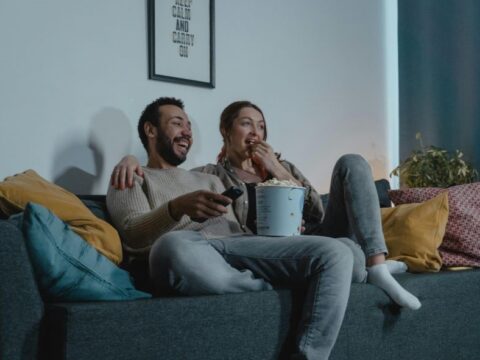Understanding the “Nervous” COVID-19 Consumer
All it takes is an “essential” trip to the grocery store to recognize we’re living in a strange time. Masked shoppers do a solemn dance, keeping a 6-foot distance and communicating who has the go-ahead with a brief nod and averted eyes.
Yet, in the next aisle, a bare-faced patron is attempting to strike up conversation with the shelf stocker.
With over a month of social distancing under our belts and increasingly bleak economic news, it’s clear that COVID-era perceptions, behaviors, and attitudes are far from “one size fits all”. MRI-Simmons’ ongoing research to better understand these differences identified two attitudinal segments: the “Accepting” group – a 65% majority who believe whatever is meant to be will be, and the smaller 35% “Nervous” group - who feel uneasy and that their world is forever altered.
In our April 21 COVID blog post, we examined additional attitudinal differences that characterize each group, as well as their outlook, things they miss most, and what types of reassurance they’ll need to feel comfortable returning to “normal” activities after the storm passes.
While it’s comforting to know that most Americans are feeling relatively calm, it’s important for businesses and marketers to understand the unique Nervous segment -- an important consumer group who are, and will be, more cautious about re-entering the marketplace even after social distancing orders loosen.
By examining who they are and how they’re interacting with the media, businesses can develop targeted plans to reach them through their preferred outlets with messages that resonate.
WHY THEY MATTER
MRI-Simmons’ ability to fuse data from the COVID study to our national Survey of the American Consumer allows us to dig beyond COVID-specific topics and unveil other attributes that set the Nervous group apart from the majority.
For starters, they skew female (57%), are 10% more likely to be parents living with at least one child, and 67% are the principal shopper in their household.
Importantly, this Nervous segment are also “Influential Consumers” – meaning they have a great deal of knowledge, and/or are often asked for their trusted advice – in several key product and service categories.1 Compared to the average adult, they’re more likely to be experts on Parenting and Dieting (+13% for each), Healthcare (+12%), Healthy Lifestyle (+11%), Shopping in general (+11%), and Grocery Shopping specifically (+10%). This group holds sway over what, where, and how American families buy everyday essentials, and their opinion of your brand matters -- perhaps now more than ever -- as we navigate the marketplace challenges during life under quarantine.
HOW THEY COPE
In our previous blog post, we noted the Nervous group is experiencing heightened levels of anxiety from pandemic news, and more depression from social distancing. It turns out, they’re more likely to suffer from these conditions even before the pandemic turned our lives upside down. In the past 12 months, 12% had anxiety or panic attacks – that’s 15% higher than the average adult. They also have above average rates of depression (+13%) and past treatment for it (+16%).
Perhaps to counterbalance a predisposition for anxiety and depression, the Nervous segment is also apt to proactively engage in wellness activities known for mind-calming benefits. A higher proportion of them are runners (+15%) or yogis (+16%), and they are 17% more likely to visit a day spa for personal care services – an antidote they’re forced to put on hold during this time of self-quarantine. With increased uncertainty and restricted coping options, now is an opportunity for wellness brands to establish resilient partnerships in well-being with these health-focused consumers by acknowledging their concerns and offering safe COVID-era alternatives.
HOW THEY STAY INFORMED
Given the above, it’s reasonable to surmise that the Nervous segment’s heightened anxiety is attributable in part to their inherent nature. The volume and range of media they engage with, however, also likely influences how they feel about COVID specifically, and presents a greater opportunity for marketers to reach them with messages that will resonate at this sensitive time.
When asked how they’re accessing news and updates about COVID-19, the Nervous segment tells us they’re heavier consumers of nearly all types of media outlets measured – and especially digital/mobile platforms. They’re looking to get up to the minute news from magazines (+41%), websites or apps of government organizations (+30%), local news (+33%), newspapers (+32%) national broadcast news (+27%), and cable news (+27%):
One in five are also looking to digital-only news aggregators like HuffPost and BuzzFeed (+14%).
Given this strong inclination to use digital media in this context, it’s fitting that they’re also more likely than most to rely on social media giants like Facebook (+14%) and Twitter (+20%) for COVID news.
Their appetite for digital news communications, however, doesn’t mean they’re eschewing traditional platforms. On the contrary, they rely on it more than the average American. When it comes to traditional TV, 47% are tuning in to national network news programs like ABC World News or the Today Show (+17% more likely than average), and 21% are watching public television news (+12%). They’re also looking to newspapers (20%, +28%) and magazines (7%, +46%) more often.
In short, they’re staying on top of this virus however they can.
Although they represent just over a third of the adult population, their leadership in key consumer areas and their high-touch media behavior make them an important group for businesses and marketers to keep a pulse on.
As COVID-19 continues to disrupt our world, subsequent waves of MRI-Simmons’ dedicated study will show us how the size of the Nervous segment is changing and examine the evolution of Americans’ attitudes about the present, and expectations for the future.
To learn more, download our COVID-19 Consumer Insights Study for free today.
*Statements used to create Category Influential Segments
1 - I have a great deal of knowledge/experience in this topic
2 - My family/friends often ask for and trust my advice on this topic



